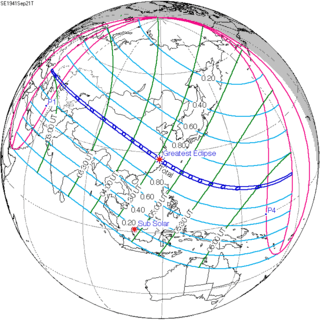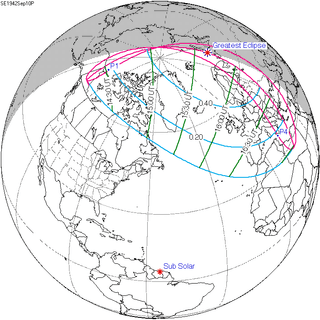Solar eclipse of March 16, 1942
| Solar eclipse of March 16, 1942 | |
|---|---|
 Map | |
| Type of eclipse | |
| Nature | Partial |
| Gamma | -1.1908 |
| Magnitude | 0.6393 |
| Maximum eclipse | |
| Coordinates | 72°12′S 76°48′W / 72.2°S 76.8°W |
| Times (UTC) | |
| Greatest eclipse | 23:37:07 |
| References | |
| Saros | 148 (17 of 75) |
| Catalog # (SE5000) | 9379 |
A partial solar eclipse occurred on March 16, 1942. A solar eclipse occurs when the Moon passes between Earth and the Sun, thereby totally or partly obscuring the image of the Sun for a viewer on Earth. A partial solar eclipse occurs in the polar regions of the Earth when the center of the Moon's shadow misses the Earth.
Related eclipses
Solar eclipses 1939-1942
Each member in a semester series of solar eclipses repeats approximately every 177 days and 4 hours (a semester) at alternating nodes of the Moon's orbit.
| Descending node | Ascending node | |||||
|---|---|---|---|---|---|---|
| Saros | Map | Saros | Map | |||
| 118 | April 19, 1939 Annular |
123 | October 12, 1939 Total | |||
| 128 | April 7, 1940 Annular |
133 | October 1, 1940 Total | |||
| 138 | March 27, 1941 Annular |
143 | September 21, 1941 Total | |||
| 148 | March 16, 1942 Partial |
153 | September 10, 1942 Partial | |||
| The partial solar eclipse on August 12, 1942 occurs in the next lunar year eclipse set. | ||||||
References
External links
- Earth visibility chart and eclipse statistics Eclipse Predictions by Fred Espenak, NASA/GSFC
| Wikimedia Commons has media related to Solar eclipse of 1942 March 16. |
This article is issued from Wikipedia - version of the 1/15/2016. The text is available under the Creative Commons Attribution/Share Alike but additional terms may apply for the media files.
